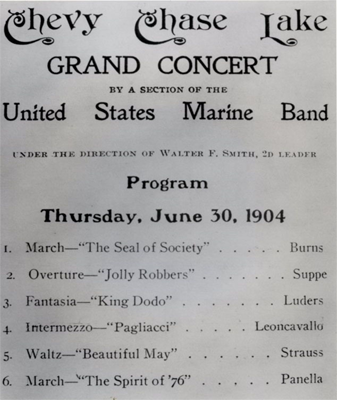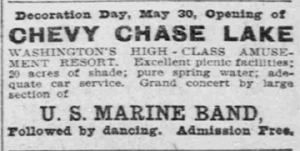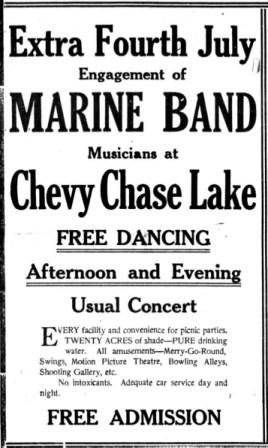
The U.S. Marine Band, 1901 - 1915
Beginning in 1901, the featured musical entertainment at Chevy Chase Lake was the U.S. Marine Band or the National Guard Band – and sometimes both together.The combination of an early evening concert followed by music for dancing until closing time at 11:00pm continued.
But there were new changes at the Lake, including the addition of a new bandstand and an expanded dancing pavilion. At the beginning of the 1901 summer season (as reported in The Washington Post, May 29, 1901, p. 29), the management of Chevy Chase Lake announced:

The new bandstand was modeled after one in Omaha, Nebraska. In a May 26 article in The Washington Post, Lieutenant Santelmann, the director of the Marine Band, declared that while the bandstand in Omaha was one of the best, the new bandstand at Chevy Chase was “an improvement.” The weekly schedule of concerts that summer included a section of the Marine Band on Tuesday, Friday, and Saturday evenings. The National Guard Band played music for dancing on the other nights. And along with the new bandstand, “rustic benches” were placed around the amusement park to provide seating for 5,000 people.
Listen to an oral history interview with Edith Claude Jarvis as she describes a band concert by the U.S. Marine Band by clicking on the YouTube link below. . Mrs. Jarvis remembered that Irene and Vernon Castle came to Chevy Chase Park to demonstrate their new way of dancing, but we haven't been able to find any additional information about the Castles performing at the amusement park.
On the 4th of July, 1901, always a special day at Chevy Chase Lake, a smaller group from the National Guard Band played from 2pm to 6pm for dancing, and then the full orchestra played in the evening, from 8 until 11pm.
The following year, in 1902, the publicity notices on June 22, p. 31 in The Washington Post describe the Marine Band’s concerts:
“Every evening, ‘rain or shine’ as it is popularly put, there is music at Chevy Chase Lake by the United States Marine Band. On the coolest evenings of last week there was a throng of fair proportions in attendance at the concerts every night. The programmes are arranged to suit every range of musical culture, both classic and popular selections being rendered.”

From 1901 through the summer of 1915, a section of the Marine Band continued to play each evening, with a concert beginning at 7:30 or 8:00 and ending at 9:00, followed by two hours of dance music. On Sundays, when there was no dancing, the evening concert was longer, and attended by many older patrons of Chevy Chase Lake.
But though the publicity pieces in the local papers state that the Park was attracting more crowds than ever, the “freak” dance craze of the early teens had an impact on the Park. The amusement park management did not allow the turkey trot and other such dances, a prohibition in keeping with the claim that Chevy Chase Lake was a “high class park.” (Read more about these new dances in the next section of this exhibit, “Dancing at the Pavilions”).
No doubt the Marine Band continued the tradition of combining light classical music with marches and popular tunes.
Click to the next page to learn about the influence of John Philip Sousa.


